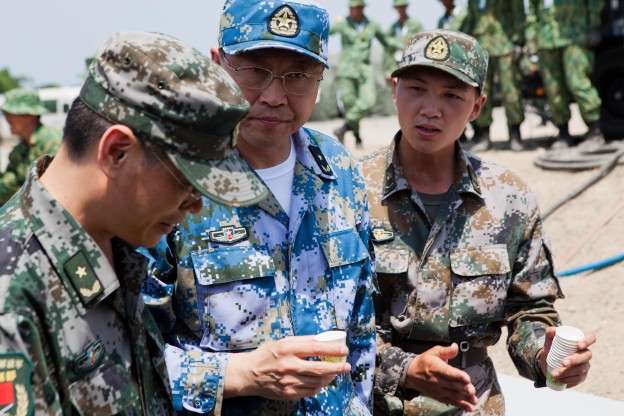
Last week Brunei hosted an important but little-noticed exercise in its portion of the island of Borneo. The multinational event sponsored by and held in conjunction with the second meeting of the Association of Southeast Asian Nations (ASEAN) Defense Ministers Meeting-Plus (ADMM-Plus) and was the first of its kind. The group focused on boosting interoperability among the participants’ medical and disaster response capabilities. But as important was the mix of participants included countries better known for tense maritime stand-offs than working together.
Technically known by the lengthy title of the Humanitarian Assistance and Disaster Response and Military Medicine Exercise (HADR & MM EX), the event involved all 10 ASEAN countries along with ASEAN’s eight partner dialogue nations: Australia, China, India, Japan, New Zealand, Russia, South Korea, and the United States.
Against the backdrop of the fictionalized Typhoon Simpur ravaging the coasts, more than 3,000 personnel from the participant countries spent four days working out the kinks of practical regional cooperation. In the scenario, Brunei’s request for assistance was routed through the ASEAN Coordinating Center for Humanitarian Assistance (AHA), which in turn established a Multi-National Coordination Center (MNCC) to process and handle all aid actions. Such assistance and training took the form of search and rescue (SAR), evacuations, medical aid, and humanitarian supply deliveries.
Improved HADR cooperation is an important goal in Asia, prone to some of the maritime regions most vulnerable to natural disasters. Speaking at a post-exercise banquet on the last night of the event, Brunei’s Deputy Minister of Defense, Dato Paduka Haji Mustappa, said the exercise had provided the ideal opportunity to learn from each other’s experiences and best practices and to develop interoperable standard operating procedures.
While the HADR and MM EX’s humanitarian goals are important in their own right, just as important is the political aspect of the participants’ blend.
Regional rivals China and Japan — at loggerheads in the East China Sea over the triply claimed Senkakus, Diaoyus and Tiaoyus island chains — both sent naval forces: Japan a Shirane-class helicopter destroyer, and China its hospital ship Peace Ark. Meanwhile the United States —restricted in its mil-to-mil cooperation with China by the 2000 National Defense Authorization Act to a few areas including SAR and HADR — sent the USNS Matthew Perry (T-AKE-9) dry cargo ship along with Marines, Seabees and civilians, who worked side-by-side with their Chinese counterparts on engineering projects.
With the addition of nations such as the Philippines, Vietnam, Russia, South Korea, Thailand, India and Malaysia the exercise marked a first for cooperation among nominal adversaries.
Such mil-to-mil exercises have been advocated by many as key efforts in keeping the peace in the Pacific through their ability to build “habits of cooperation.” Such habits help to prevent conflicts arising from “misunderstanding, mistakes, or the misbehavior of a rogue command or commander.” They are “vital to diffusing those instances when misunderstanding and accidents lead to a stand-off with few face-saving options”, and also helpful in de-escalating those conflicts sprung from different causus belli. That is to say they may not help prevent a war driven by a rational policy calculation, nor a war started by a regime on the ropes, but these habits can help a cold war or “cool war” from heating up.
“It is important for ASEAN members not to get caught with [their] pants down when disasters strike,” Mustappa said.
It is just as important for ASEAN members, and the United States, to have counterparts in China’s military willing to believe their fellow mariners are acting, communicating, and negotiating in good faith when disaster of a man-made variety strikes.
The good news is that the outlook for such exercises continuing looks promising. China, the United States, and Japan’s Maritime Self-Defense Force have and will continue to engage in counter-piracy drills off the Horn of Africa and 2014’s Rim of the Pacific exercise will for the first time include China. Here’s hoping, with a healthy appreciation of the limits such cooperation can deliver, that the trend continues – both for the immediate goals of boosted capability and the less tangible goal of a less contentious rivalry.




